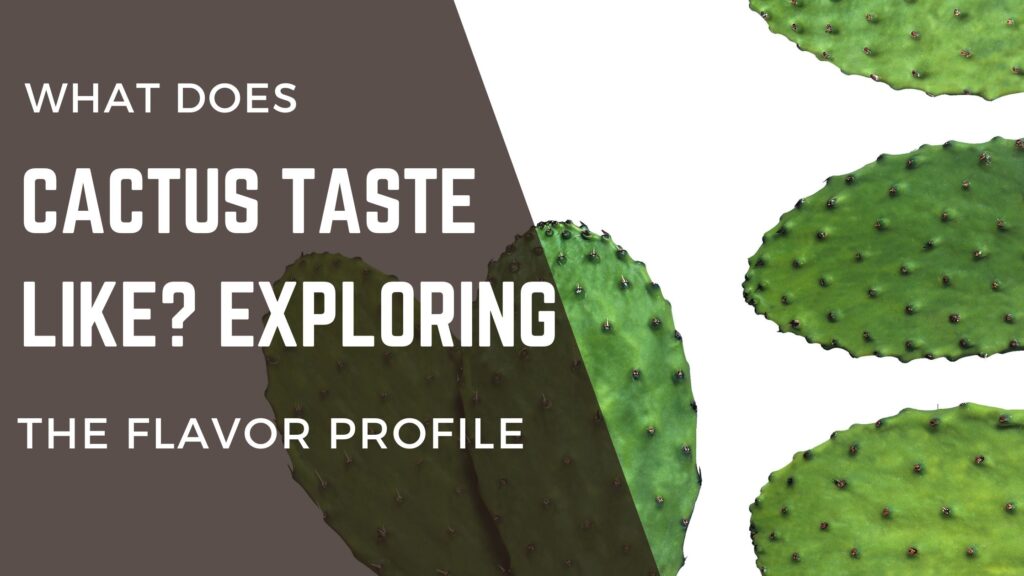Have you ever wondered what cactus tastes like? You may be surprised to learn that cactus is a popular ingredient in many cuisines worldwide. From Mexico to Africa, cactus has been used for centuries as a source of food and water.
The taste of cactus can vary depending on the type of cactus and how it is prepared. Some varieties have a slightly sweet, mild flavor, while others are more tart or bitter. In general, cactus has a crunchy texture and a refreshing taste that is similar to cucumber or green beans.

What does cactus taste like?
If you’ve never tasted cactus, you might wonder what it tastes like. The taste of cactus can vary depending on the type of cactus you’re eating and how it’s prepared. Here are some general descriptions of the taste of cactus:
- Prickly pear cactus: The fruit of the prickly pear cactus has a sweet and slightly tart taste, similar to a cross between a watermelon and a strawberry. The texture is similar to a pear, but with a slightly grainy texture due to the seeds.
- Nopales cactus: The pads of the nopales cactus have a mild, slightly tart taste, similar to green beans or asparagus. The texture is slightly slimy, similar to okra.
- Barrel cactus: The fruit of the barrel cactus has a very sour taste, similar to a lemon or lime. The texture is similar to a kiwi but with more seeds.
Cactus is often used in Mexican cuisine, commonly grilled or sautéed with onions and peppers. It’s also used in salads, salsas, and even drinks. In addition to its unique taste, cactus is a good source of fiber, vitamins, and minerals.
What is Cactus
If you’re wondering what a cactus is, it’s a plant that belongs to the family Cactaceae. Cacti are native to the Americas, from Canada to Patagonia, and are known for their unique appearance, with spines or thorns instead of leaves.
Cacti come in various shapes and sizes, from small and round to tall and columnar. They can also survive in harsh, dry environments that other plants can’t tolerate.
In addition to being ornamental plants, some cactus species are also used for food and medicine.
The most commonly eaten part of the cactus is the pad, also known as the nopales or nopalitos. These are the flattened, oval-shaped segments that grow from the cactus stem.
Nopales are a common ingredient in Mexican cuisine and are often used in salads, soups, stews, and tacos. When cooked, they have a slightly tart, citrusy flavor and a slightly slimy texture.
They’re also a good source of fiber, vitamins, and minerals.
Cactus fruit, also known as prickly pear, is consumed in some cultures. The fruit is sweet and juicy, similar to watermelon or kiwi. It’s often used to make jams, jellies, and syrups or eaten fresh.
The cactus is a versatile plant with many uses beyond just being decorative. Its unique adaptations to harsh environments make it an exciting and essential part of the plant world.
Taste Profile of Cactus
Regarding the taste profile of cactus, it is essential to note that there are many different types of cactus, each with its unique flavor. However, cactus generally has a mild, slightly sweet taste with a slightly tangy and refreshing finish.
The texture of cactus can vary depending on how it is prepared. Cactus has a slightly slimy texture when cooked, similar to okra or aloe vera.
However, when eaten raw, cactus has a crunchy texture similar to cucumber or green pepper.
One of the most popular ways to eat cactus is in a salad. Cactus add unique flavor and texture to the dish when combined with other fresh vegetables. It can also be sautéed or grilled and used as a filling for tacos or burritos.
Cactus Varieties
If you’re curious about what cactus tastes like, you can try a few different varieties. Here are some of the most common:
Prickly Pear
Prickly pear, known as nopales, is one of the most commonly eaten cactus varieties.
Its pads, which are flat and oval-shaped, are often used in Mexican cuisine.
They can be grilled, sautéed, or boiled and added to salads, tacos, and other dishes. The fruit of the prickly pear cactus is also edible and is often used in jams, jellies, and drinks.
Saguaro
The saguaro cactus is one of the most iconic symbols of the American Southwest. It’s also edible but not as commonly consumed as prickly pear.
The flesh of the saguaro is pulpy and sweet, often used to make jams, syrups, and candy. The seeds of the saguaro can also be roasted and eaten.
Barrel Cactus
Barrel cactus is another variety that’s sometimes eaten. Its flesh is watery and slightly sweet, and it can be eaten raw or cooked.
However, it’s important to note that some species of barrel cactus are toxic, so it’s important to know what you’re eating before you try it.
Overall, cactus is a unique and exciting food to try. Plenty of cactus varieties exist whether you’re interested in the taste or want to try something new.
Culinary Uses of Cactus
Cactus is a versatile ingredient that can be used in various culinary dishes. The fruit and pads of the cactus are both edible and have unique flavors and textures. Here are some ways you can use cactus in your cooking:
Cactus Fruit
Cactus fruit, also known as prickly pear, is a sweet and juicy fruit that can be eaten raw or used in various recipes. Here are some ideas:
- Add diced cactus fruit to a fruit salad for a pop of color and flavor.
- Make a prickly pear margarita by blending cactus fruit with tequila, lime juice, and ice.
- Use cactus fruit puree as a topping for ice cream or yogurt.
Cactus Pads
Cactus pads, known as nopales, have a slightly sour taste and crunchy texture. They can be eaten raw or cooked and are often used in Mexican cuisine. Here are some ways to use cactus pads:
- Grill or sauté cactus pads and add them to tacos or burritos.
- Make a cactus salad by slicing cactus pads and tossing them with tomatoes, onions, and cilantro.
- Use cactus pads in a stir-fry with other vegetables and protein.
Cactus can also be used to make jams, jellies, and syrups. It’s important to note that cactus pads have tiny spines that must be removed before eating. You can use a vegetable peeler or knife to remove the spines or purchase pre-cleaned cactus pads from a specialty store.
Cactus Harvesting and Preparation
When it comes to harvesting cactus, taking precautions is essential to avoid getting pricked by the spines. You should wear thick gloves and use tongs or pliers to handle the cactus pads.
To prepare cactus for cooking, remove the spines with a sharp knife or vegetable peeler. Be sure to remove all the spines, as they can be pretty sharp and unpleasant to eat.
Next, trim off the edges of the cactus pads and rinse them thoroughly to remove any remaining spines or debris.
Cactus can be eaten raw or cooked, depending on your preference. If you eat it raw, slice it thinly and add it to salads or sandwiches.
If you prefer to cook it, there are many ways to prepare cactus, including grilling, sautéing, or boiling.
One popular way to cook cactus is to boil it for several minutes to remove the slimy texture, then sauté it with onions and garlic. Another option is to grill cactus pads until they are slightly charred, then slice them and add them to tacos or fajitas.
Cautions and Considerations
When trying cactus for the first time, remember a few things to ensure a safe and enjoyable experience.
Firstly, it’s important to note that not all cacti are edible. Some species contain toxins that can be harmful or even lethal if ingested. Make sure to do your research and only consume cacti that are known to be safe for human consumption.
Additionally, cactus can be pretty prickly, so handling it carefully is essential.
Use gloves or a towel to protect your hands when preparing the cactus, and remove all the spines before cooking or eating.
Another consideration is the texture of the cactus. Some people find it slimy or mucilaginous, which can be off-putting. If unsure about the texture, try incorporating cactus into a dish with other ingredients to balance it.
Finally, if you have any allergies or medical conditions, it’s best to consult with a healthcare professional before trying cactus. While it’s generally considered safe, it’s always better to err on caution.

Frequently Asked Questions
What does cooked cactus taste like?
Cooked cactus has a slightly tangy and slightly sweet taste. The texture of cooked cactus is similar to that of green beans or okra. It is often compared to the taste of asparagus or green peppers.
How does cactus fruit taste?
Cactus fruit, or prickly pear, tastes sweet and slightly tart. The fruit’s texture resembles watermelon’s but with small, crunchy seeds. The taste is often described as a cross between a watermelon and a strawberry.
What does cactus juice taste like?
Cactus juice has a slightly sweet and refreshing taste. It is often compared to a mild green apple or cucumber taste. The juice is often used in cocktails or as a base for smoothies.
Is cactus good for you?
Cactus is a good source of fiber, vitamins, and minerals. It is low in calories and can help regulate blood sugar levels. Cactus is also known for its anti-inflammatory properties and can help improve digestion.
How do you cook cactus?
To cook cactus, you first need to remove the prickly spines and outer layer of the cactus pads. Once cleaned, the cactus can be boiled, grilled, or sautéed. It is often used in Mexican cuisine as a filling for tacos or a side dish.
What does a cactus taco taste like?
Cactus taco has a slightly tangy and slightly sweet taste. The texture of the cooked cactus is similar to that of green beans or okra. The taste is often enhanced with spices such as chili powder or cumin. It is a popular vegetarian option for tacos.
How to Cook Red Lentils: A Simple Guide for Beginners